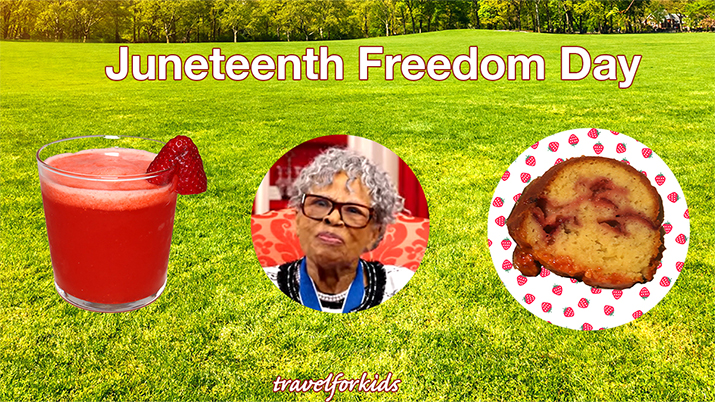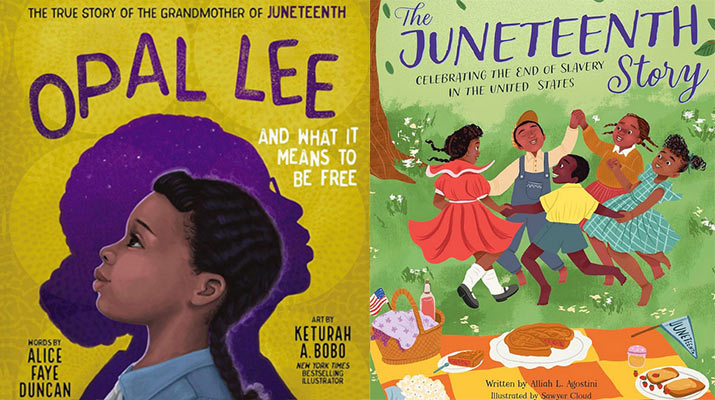
June 19 is Juneteenth, our newest national holiday, celebrating freedom of enslaved African Americans in 1865.
During the Civil War, President Lincoln signed the Emancipation Proclamation, which freed all slaves January 1, 1863.
However, after the Proclamation, people from Southern states moved to Texas, taking their slaves with them. Slave owners kept the slaves working for free on the plantations, hiding news of their freedom.
On June 19, 1865, white people and slaves gathered at Ashton Villa in Galveston Texas.
Major General Gordon Granger read the following words, “The people of Texas are informed that, in accordance with a proclamation from the Executive of the United States (President Lincoln), all slaves are free.”
On Juneteenth, families, communities, cities celebrate with parades, with music, singing, dancing, fireworks, and fun food!
Two Juneteenth Recipes

Red is a special color, reminder of slave endurance and African traditions. Strawberries and watermelons are in peak season in June, red drinks and barbeque are on the menu, along with other Southern dishes, such as red velvet cake and strawberry pie.
Strawberry Lemonade
2 cups fresh strawberries, stems removed, or 2 cups frozen strawberries, thawed.
½ cup sugar
1 cup fresh squeezed lemon juice (about 8 lemons), or one 12 oz can lemonade concentrate
6 or 7 cups cold water
Slice the strawberries.
Put strawberries, sugar, lemon juice in blender, with 6 cups of water.
Pulse mixture few times. Then blend at low speed 2 minutes.
Gradually turn up speed to medium. Blend until smooth.
If lemonade is too thick, gradually add in more water.
Pour into pitcher until ready to serve.
Serve over ice.
Recipe from Opal Lee and What It Means to Be Free. See book below.
Fresh Strawberry Bundt Cake
CAKE:
¾ cup unsalted butter (1 ½ sticks) softened, plus butter to grease pan
3 cups all purpose flour, plus flour to grease ban
1 ½ tsp baking powder
½ tsp baking soda
1 ¼ tsp salt
1 ½ cups sugar
1 tsp lemon zest
3 large eggs at room temperature
1 ¼ cups whole milk yogurt
¼ cup lemon juice
1 tsp vanilla extra
2 ¾ cups fresh strawberries (about 1 pound), chopped into ½ inch pieces.
GLAZE:
¼ cup strawberries
2 cups powdered sugar, sifted
2 -3 tsp lemon juice
Position rack in center of oven, heat to 325 degrees. Carefully butter and flour Bundt pan, making sure to get all places.
In medium bow, whisk together flour, baking powder, baking soda, and salt. Set aside.
In bowl of stand mixer, mix butter and sugar until combined. Add lemon zest, then cream mixture until light and fluffy on medium-high speed, about 5 minutes.
With mixer on low, add the eggs one at a time. Add the yogurt, lemon juice and vanilla, and mix on medium speed to combine, scraping sides of bowl as necessary. The mixture may curdle slightly, don’t worry too much about it.
All flour mixture all at once, mix on low until almost completely combined.
Remove bowl from mixture, scape any excess flour into the batter. Scoop out 1 /2 cup batter. Drop tablespoons of batter into the Bundt pan, and smooth bottom of the pan. Add chopped strawberries to remaining batter in the mixer bowl, and gently fold in until strawberries are evenly distributed. Batter will be thick.
Spoon batter evenly into the Bundt pan, smooth top, tap pan on counter few times to release any any bubbles. Bake cake until golden brown, and skewer in center comes out clean, about 70 minutes.
Cool pan on a rack 15 minutes, then turn out cake on rack to cook completely.
Make the glaze. Use fork to mash the reserved ¼ cup strawberries. Whisk in powdered sugar and lemon juice. Glaze should be thick, but pourable. If it seems thin, add more sugar, if too thick, as more lemon juice.
Pour glaze evenly over the cake.
Tip: Cake is best eaten same day, but we found it delicious for breakfast too.
Recipe from Cooking – New York Times.
Juneteenth Children’s Books
Opal Lee and What It Means to Be Free by Alice Faye Duncan, Keturah A. Bobo.
What an inspiring book! Opal Lee tells Juneteenth stories to a group of kids, including her great grandson. In her long life, she encountered whites only” laws, city zoo was open only one day a year to Black Americans, her family home was burned to the ground by a racist mob.
But she wasn’t deterred. To the children she says, “Remember my words for safekeeping. Remember that I say. Freedom is for everyone. Juneteenth is YOU and ME.”
Book includes recipe for Strawberry Lemonade, Juneteenth timeline and biography of Opal Lee. (Picture book)
Note: Opal Lee is the “Grandmother of Juneteenth.”
In her 90ties, Opal Lee walked from Texas to Washington DC to get over 1.5 million signatures for a petition to present to Congress. In 2021, she stood with President Biden at the White House, when Juneteenth was declared a national holiday.
June 14, 2024. Opal Lee moved into her new house today in Fort Worth. It’s on the same lot where her home burned down 80 years ago on Juneteenth.
The Juneteenth Story by Alliah L. Agostini, Sawyer Cloud.
Juneteenth, June 19, is the national holiday that celebrates end of slavery in the United States. It marks the day in June 1865 that Black people finally were free by law. Today Juneteenth is celebrated throughout America with parades, food and festivals, where families get together and remember their heritage of enslaved ancestors. (Picture book)
A Flag for Juneteenth by Kim Taylor.
On Juneteenth, a girl celebrates her birthday, then she helps her community create a freedom flag, with a five pointed star, and another quilt with a sunburst for new freedom for everyone. All the illustrations are quilted scenes with words, created by the author. (Picture book)
Note: Embroidery and weaving traditions from Africa were brought to America by enslaved people. Slave women made quilts in beautiful geometric designs from scraps of cloth, quilts that kept their family warm, and also quilts that told the history of families and communities
What is Juneteenth? by Kirsti Jewel, Manuel Guitierrez.
Illustrated history of African Americans and Juneteenth holiday, from centuries of slavery, Civil War, to June 19, 1865 when slaves were finally freed in Texas. But segregation, Jim Crow laws made it difficult have Juneteenth celebrations even in public parks. Black Americans left the South to have a freer life in Northern cities, but racism persisted. In 1960s civil rights era protests and new laws promoted equal rights for Black people.
Since 1866, Juneteeth has been celebrated in homes, parks, and large cities throughout the United States, and now it is a national holiday. Good for older kids (Chapter book)

